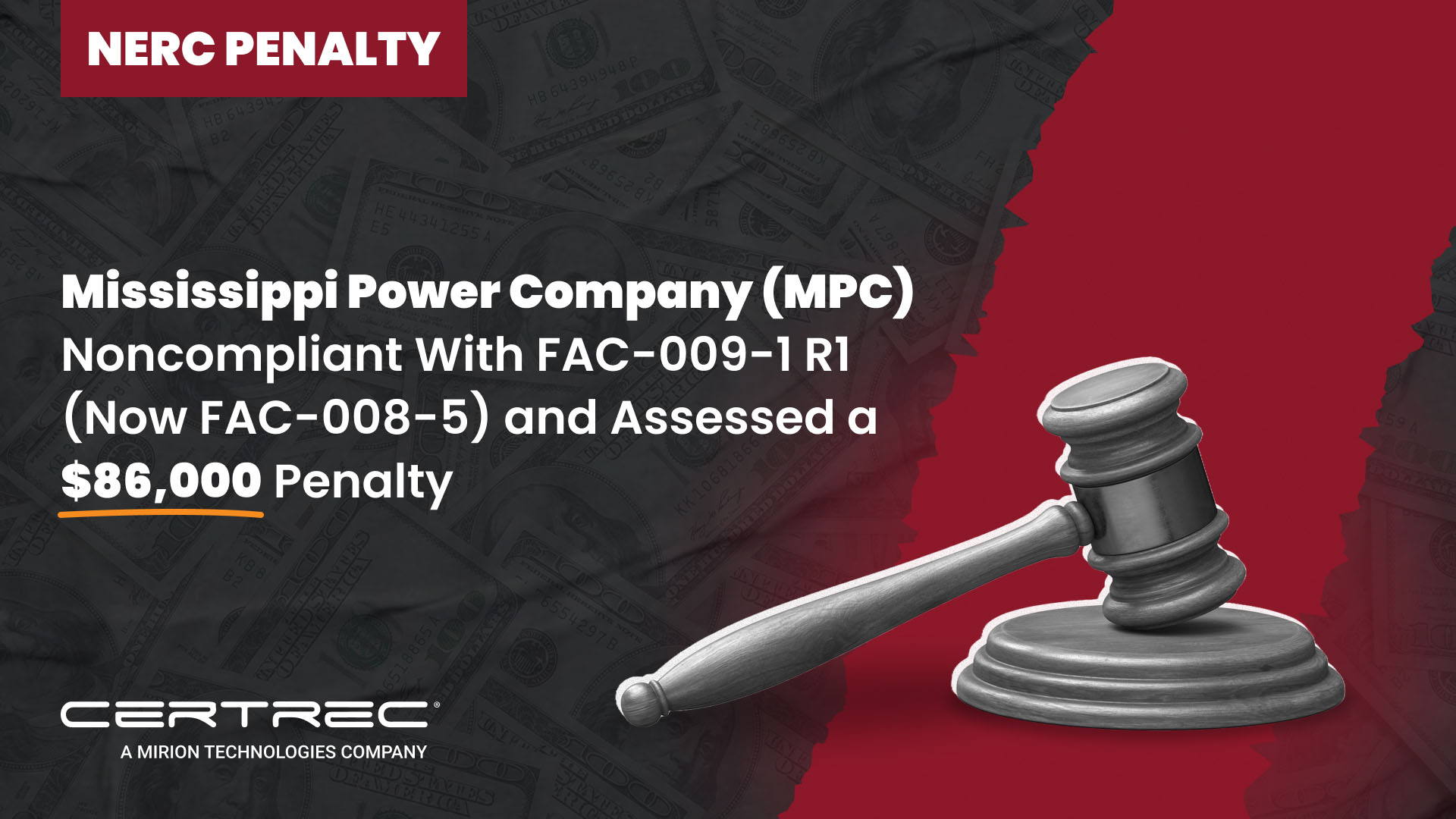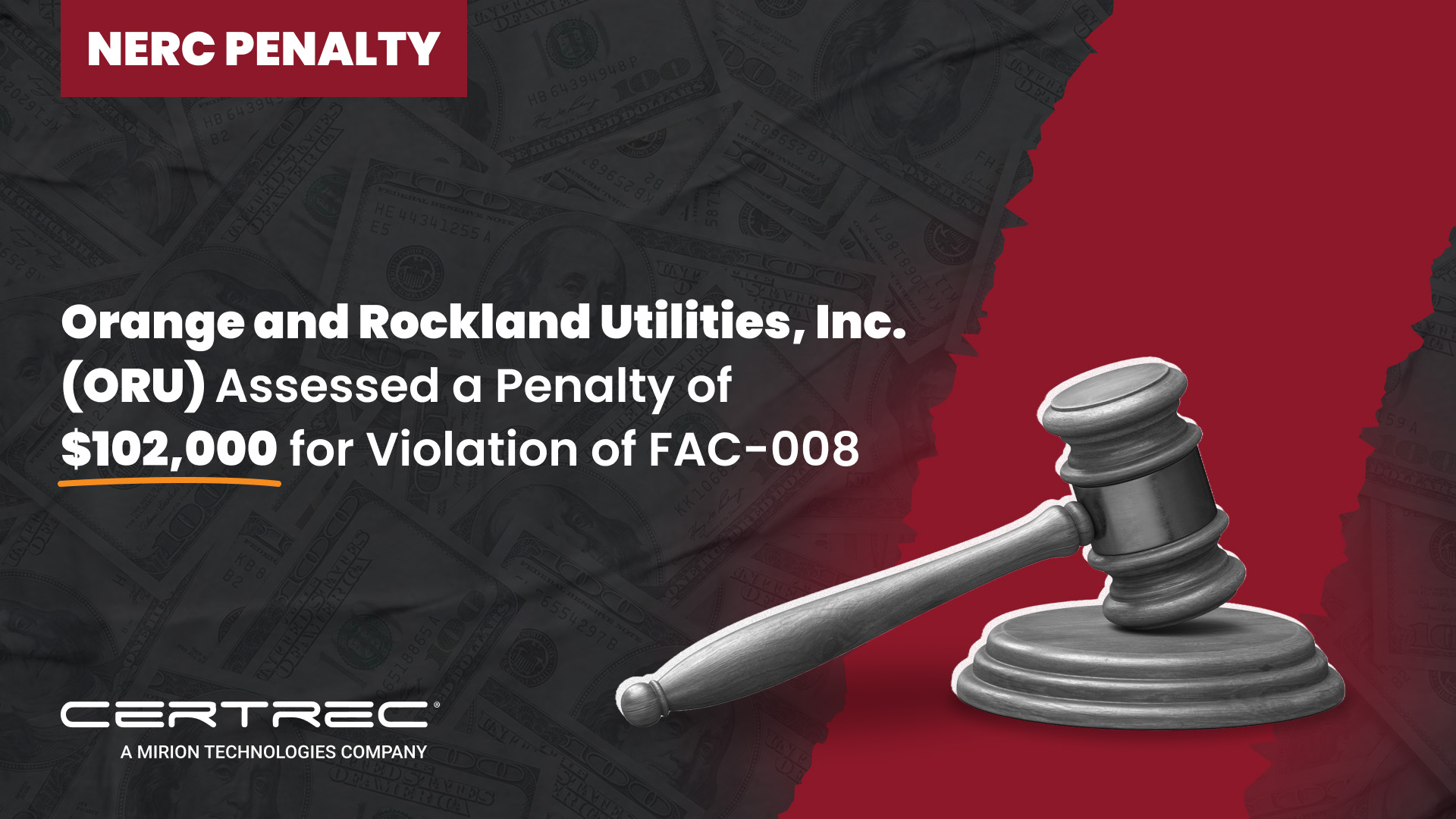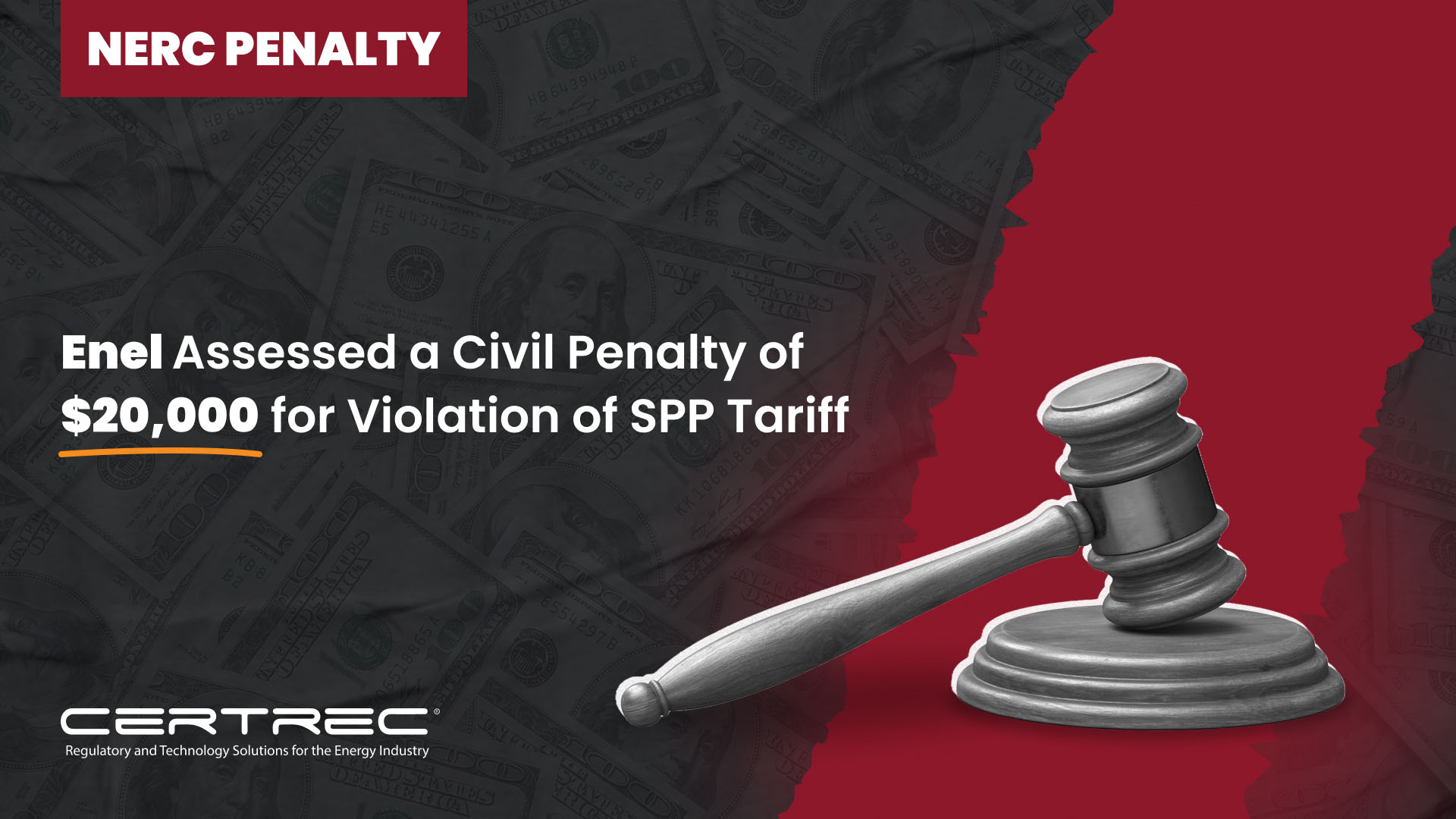Long Island Power Authority (LIPA) FAC-008-3 R6 Violation Results in $96,000 Penalty
Summary of NERC Penalties
REGION | WHEN? | ENTITY | COMPLIANCE AREA | VIOLATION | REASON | PENALTY AMOUNT |
|---|---|---|---|---|---|---|
NPCC | Quarter 2 - June 2024 | Long Island Power Authority (LIPA) | NPCC's Regulations | FAC-008-3 R6 | Long Island Power Authority (LIPA) failed to determine facility ratings consistent with Facility Ratings Methodology (FRM) due to ineffective internal procedures, database transposition errors, and ineffective detective control for pump house field configuration changes. Self-reported, involving 24 facilities with incorrect ratings and an additional 2 facilities found noncompliant later, resulting in a total of 26 noncompliant facilities. | $96,000 |
Summary:
Long Island Power Authority (LIPA) submitted a Self-Report to NPCC stating that, as a Transmission Owner (TO), it was potentially in violation of FAC-008-3 R6 for failing to determine Facility Ratings consistent with its Facility Ratings Methodology (FRM). The Self-Report identified Facility Rating discrepancies impacting 24 Facilities, equivalent to approximately 19 percent of LIPA’s 128 applicable Bulk Electric System (BES) Facilities. Of the 24 total noncompliant Facilities, nine 138 kV cables had incorrect seasonal Facility ratings. These cables require seasonal rating changes in the Energy Management System (EMS) based on their pump house field configurations. Specifically, the EMS Facility ratings did not match pump house field configurations, resulting in some limited overloading conditions relative to the cables’ correct ratings. LIPA conducted a review of its engineering drawings and a targeted walk down of its BES Facilities as part of its extent of condition review. This resulted in the identification of fifteen 138 kV Facilities, comprised of nine feeders and six transformers, with Facility Ratings that did not consider the Most Limiting Element (MLE). The 15 Facilities were newly identified as BES Elements as a result of the revised BES definition effective on July 1, 2016. During a walk down conducted in October 2023, LIPA discovered an additional two 138 kV cables were operating in the field in static mode, while circulate ratings were being utilized in the EMS for real-time system operation. Before LIPA could implement mitigation to prevent reoccurrences, on January 31, 2024, LIPA discovered one of the two 138 kV cables was once again operating in the field in static mode, while circulate ratings were being utilized in the EMS, bringing the total number of noncompliant Facilities to 26 and the total number of instances to 27.
Additional Discussion:
Cause
The root cause for the 15 Facilities, where LIPA failed to determine Facility Ratings consistent with its FRM, was ineffective internal procedures for ensuring the accuracy of Facility Ratings, including ineffective interdepartmental coordination and an inadequate process for considering the MLE. The root cause for the nine cables, where LIPA failed to set correct cable seasonal ratings, was a database transposition error. The root cause of the two noncompliant cables found in 2023 and the additional instance that occurred in 2024 was an ineffective detective control to alert personnel of the pump house field configuration change and a lack of awareness that such a change would occur under the circumstances.
Disposition
NPCC determined that the violation posed a moderate risk to the reliability of the BPS based on the following factors.
- A failure to have Facility Ratings that are consistent with the associated Facility Ratings methodology or documentation for determining Facility Ratings could lead to an incorrect Facility Rating if a missing, or incorrectly rated component turns out to be the MLE.
- In all cases of incorrect Facility Ratings, the System Operator is operating with a decreased level of situational awareness in real-time and is monitoring contingencies with reduced accuracy.
- Incorrect Facility Ratings also result in inaccurate system planning, including planning during short-term studies, long term-studies, seasonal assessments, capital project studies, and other studies.
- Incorrectly inflated ratings increase the likelihood of equipment damage or failure which could adversely affect the BPS. It also increases the risk that the System Operator is operating to incorrect System Operating Limits or Interconnection Reliability Operating Limits.
- If the Facility Rating was too low, it could have resulted in unnecessary reductions in transfer, or generator output, and/or a perception of congestion that did not really exist. Whether the incorrect ratings were too high or too low, System Operators could have been required to implement reliability actions that otherwise would not have been needed.
- LIPA’s peak load from 2020-2023 ranged from approximately 5,200 MW to 5,500 MW. Twenty-six Facilities, equivalent to approximately 20 percent of LIPA’s 128 applicable BES Facilities, operated with incorrect Facility ratings during the period of noncompliance. Because LIPA is a summer peaking entity, its summer peak conditions are the most significant. With respect to Normal ratings for the summer peak load period, mitigation of the violation required an increased rating for one 138 kV feeder by 19 MW (+9 percent change), a decreased rating for two 138 kV feeders up to 98 MW (-20 percent change), and a decreased rating for four transformers, up to 50 MW (-12 percent change). The nine cables that had wrong seasonal ratings, all had higher Summer Normal ratings set than what should have been applied, up to 52 MW (-14 percent difference). Remediation of the two additional noncompliant cables found in 2023 resulted in decreased ratings, up to 35 MW (-14 percent difference). However, the duration of this instance was short, and the two cables never exceeded their respective static ratings during the 10 days of noncompliance. The instance of the noncompliant cable discovered in 2024 occurred in the off-peak season and, therefore, had no impact on LIPA’s summer peak conditions. The remaining six feeders and two transformers experienced no change in their Summer Normal ratings.
- According to LIPA’s more comprehensive, year-round analysis of the historical performance of all 26 noncompliant Facilities, six Facilities comprised of two 138 kV feeders and four transformer banks exceeded the corrected ratings 95 times in a five-year period. These exceedances did not affect any Critical Facilities, and all occurred during off-peak operating conditions except for one exceedance that occurred on a high-load day during a Summer Dependable Maximum Net Capability test for the generating unit associated with the Bank. All exceedances were of the Facilities’ Normal ratings, with one single exception where a Long-Term Emergency (LTE) rating was momentarily exceeded for 20 seconds.
- LIPA determined that the above Facilities have not been damaged by these exceedances and have not suffered a loss of service life. LIPA also reported that the Facilities have been operated for approximately 50 years without any identifiable damage or adverse effects.
- LIPA has operating controls in place to mitigate the effect of operational issues that may be caused by noncompliance with this Standard. The SCADA/EMS system used by its control center provides real-time telemetry of power flow on monitored transmission lines and transformers for MW, MVAR, amperage and bus voltages in kV. SCADA will generate audible and visible alarms to System Operators when monitored system Facilities are being operated in excess of real-time limits. Additionally, LIPA’s Real-Time Network Analysis (RTNA)/Real-Time Contingency Analysis (RTCA) applications continuously run on a time trigger every five minutes, or every time a 69 kV or higher voltage breaker has been operated and evaluates LIPA’s system for N-1 post-contingency violations. Under most circumstances, LIPA is able to resolve Real-time rating exceedances by modifying power flow distribution over its system via six Phase-Angle-Regulators (PARs) and/or dispatch of interconnected generation resources.
- None of the noncompliant Facilities are part of IROLs or tie-lines with neighboring systems. The de-rated Facilities have not caused a decrease in overall system resources needed to reliably serve LIPA customer load. Furthermore, LIPA’s Reliability Coordinator, NYISO, carries required operating reserves of 1,965 MW and could have adequately addressed potential reliability gaps arising from this violation. No harm is known to have occurred.
- NPCC considered the following factors in its penalty determination resulting a civil penalty of $96,000:
- When assessing the penalty for the violation at issue in this Agreement, NPCC considered whether the facts of the violation constitute repetitive infractions and determined that LIPA had no relevant prior noncompliance with FAC-008-3 R6.
- LIPA has been cooperative throughout the entire enforcement process for this violation. LIPA provided requested information to NPCC that was detailed, organized, and thorough.
- LIPA self-reported the violation described in this Agreement. Effective oversight of the BPS reliability depends on Registered Entities self-reporting. As such, NPCC seeks to encourage self-reporting of violations and, therefore, is applying mitigating credit in the instant case.
- LIPA agreed to settle the violation thereby avoiding a hearing on this matter. A willingness to resolve cases without the need for a trial-type hearing reduces the amount of time and resources that NPCC, NERC, and the FERC would otherwise expend to resolve this violation. Additionally, it is important to promote prompt resolution of enforcement actions so that LIPA can focus on mitigation and reducing risks to reliability.
About Certrec:
Certrec is a leading provider of regulatory compliance solutions for the energy industry with the mission of helping ensure a stable, reliable, bulk electric supply. Since 1988, Certrec’s SaaS applications and consulting expertise have helped hundreds of power-generating facilities manage their regulatory compliance and reduce their risks.
Certrec’s engineers and business teams bring a cumulative 1,500 years of working experience in regulatory areas of compliance, engineering, and operations, including nuclear, fossil, solar, wind facilities, and other Registered Entities generation and transmission.
Certrec has helped more than 200 generating facilities establish and maintain NERC Compliance Programs. We manage the entire NERC compliance program for 80+ registered entities in the US, Canada, and Mexico that trust us to decrease their regulatory and reputational risk. Certrec is ISO/IEC 27001:2013 certified and has successfully completed annual SOC 2 Type 2 examinations.
For press and media inquiries, please contact marketing@certrec.com.
Share









